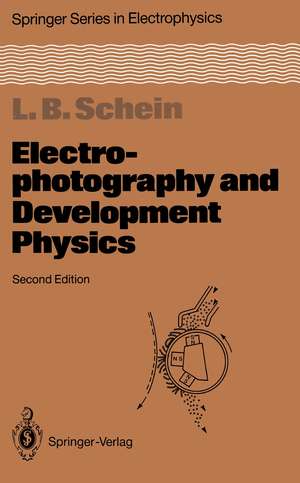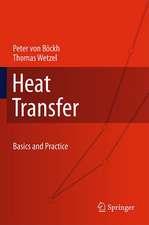Electrophotography and Development Physics: Springer Series in Electronics and Photonics, cartea 14
Autor Lawrence B. Scheinen Limba Engleză Paperback – 12 noi 1992
Din seria Springer Series in Electronics and Photonics
-
 Preț: 389.49 lei
Preț: 389.49 lei - 15%
 Preț: 644.18 lei
Preț: 644.18 lei - 15%
 Preț: 653.79 lei
Preț: 653.79 lei - 15%
 Preț: 648.74 lei
Preț: 648.74 lei -
 Preț: 391.02 lei
Preț: 391.02 lei - 15%
 Preț: 645.47 lei
Preț: 645.47 lei -
 Preț: 389.11 lei
Preț: 389.11 lei -
 Preț: 380.45 lei
Preț: 380.45 lei -
 Preț: 384.09 lei
Preț: 384.09 lei -
 Preț: 394.29 lei
Preț: 394.29 lei - 15%
 Preț: 643.16 lei
Preț: 643.16 lei - 18%
 Preț: 730.35 lei
Preț: 730.35 lei - 15%
 Preț: 526.35 lei
Preț: 526.35 lei - 15%
 Preț: 638.11 lei
Preț: 638.11 lei -
 Preț: 390.63 lei
Preț: 390.63 lei - 15%
 Preț: 641.03 lei
Preț: 641.03 lei - 15%
 Preț: 637.46 lei
Preț: 637.46 lei -
 Preț: 396.24 lei
Preț: 396.24 lei -
 Preț: 395.09 lei
Preț: 395.09 lei -
 Preț: 381.81 lei
Preț: 381.81 lei -
 Preț: 395.47 lei
Preț: 395.47 lei - 15%
 Preț: 646.30 lei
Preț: 646.30 lei - 15%
 Preț: 633.35 lei
Preț: 633.35 lei -
 Preț: 383.93 lei
Preț: 383.93 lei - 15%
 Preț: 641.71 lei
Preț: 641.71 lei -
 Preț: 391.99 lei
Preț: 391.99 lei -
 Preț: 395.09 lei
Preț: 395.09 lei -
 Preț: 390.46 lei
Preț: 390.46 lei - 15%
 Preț: 641.53 lei
Preț: 641.53 lei - 15%
 Preț: 642.18 lei
Preț: 642.18 lei - 15%
 Preț: 642.18 lei
Preț: 642.18 lei - 18%
 Preț: 949.23 lei
Preț: 949.23 lei
Preț: 393.13 lei
Nou
Puncte Express: 590
Preț estimativ în valută:
75.24€ • 78.26$ • 62.11£
75.24€ • 78.26$ • 62.11£
Carte tipărită la comandă
Livrare economică 14-28 aprilie
Preluare comenzi: 021 569.72.76
Specificații
ISBN-13: 9783540558583
ISBN-10: 3540558586
Pagini: 384
Ilustrații: XX, 363 p. 65 illus.
Dimensiuni: 155 x 235 x 20 mm
Greutate: 0.54 kg
Ediția:Softcover reprint of the original 2nd ed. 1992
Editura: Springer Berlin, Heidelberg
Colecția Springer
Seria Springer Series in Electronics and Photonics
Locul publicării:Berlin, Heidelberg, Germany
ISBN-10: 3540558586
Pagini: 384
Ilustrații: XX, 363 p. 65 illus.
Dimensiuni: 155 x 235 x 20 mm
Greutate: 0.54 kg
Ediția:Softcover reprint of the original 2nd ed. 1992
Editura: Springer Berlin, Heidelberg
Colecția Springer
Seria Springer Series in Electronics and Photonics
Locul publicării:Berlin, Heidelberg, Germany
Public țintă
Professional/practitionerCuprins
1. Introduction.- 1.1 Technical History.- 1.2 Copier Market.- 1.3 Printer Market.- 1.4 Alternative Powder Marking Technologies.- 2. The Electrophotographic Process.- 2.1 The Six Steps of Electrophotography.- 2.2 Implementation-Interactions.- 2.3 Subsystem Choices.- 3. The Development Step.- 3.1 Challenges.- 3.2 Focus.- 3.3 Descriptions.- 4. Toner Charging for Two Component Development Systems.- 4.1 Metal-Metal Contact Charging.- 4.2 Metal-Insulator Contact Charging.- 4.3 Insulator-Insulator Contact Charging.- 4.4 Toner-Carrier Charging.- 4.5 Summary.- 5. Cascade Development.- 5.1 Development Mechanisms.- 5.2 Experimental Work.- 5.3 Theory Ill.- 5.4 Summary.- 6. Insulative Magnetic Brush Development.- 6.1 Qualitative Comparison of Development Mechanisms.- 6.2 The Electric Field.- 6.3 Theories of Solid Area Development.- 6.4 Solid Area Development Experiments.- 6.5 Line Development.- 6.6 Background Development.- 6.7 Improvements.- 6.8 Summary.- 7. Conductive Magnetic Brush Development.- 7.1 Initial Theoretical Ideas.- 7.2 Experimental Data and Discussions.- 7.3 Infinitely Conductive Theory.- 7.4 Comparison with Experiment.- 7.5 Line Development.- 7.6 Background Development.- 7.7 Summary.- 8. Toner Charging for Monocomponent Development Systems.- 8.1 Induction Charging.- 8.2 Injection Charging.- 8.3 Contact Charging.- 8.4 Corona Charging.- 8.5 Charging Methods for Powder Coating.- 8.6 Other Charging Methods.- 8.7 Traveling Electric Fields.- 9. Monocomponent Development.- 9.1 Aerosol or Powder Cloud Development.- 9.2 Early Work.- 9.3 Theory of Monocomponent Development.- 9.4 Conductive Toner.- 9.5 Magnetic, Insulative Toner.- 9.6 Nonmagnetic, Insulative Toner.- 9.7 Summary.- 10. Liquid Development.- 10.1 Material Requirements.- 10.3 Toner Characteristics.- 10.4 Recent Developments.- 10.5 Summary.- 11. Color Electrophotography.- 11.1 History.- 11.2 Image Quality.- 11.3 Colored Toner Accumulation.- 11.4 New Development Systems.- 11.5 Color Market.- 11.6 Current Copier Products.- 11.7 Current Printer Products.- 12. Update of Chapters 1–10.- 12-1.2 Copier Market.- 12-1.3 Printer Market.- 12-1.4 Alternative Powder Marking Technologies.- 12-4 Toner Charging for Two Component Development Systems.- 12-4.3 Insulator-Insulator Contact Charging.- 12-4.4 Toner-Carrier Charging.- 12-6.4 Solid Area Development Experiments.- 12-6.6 Background Development.- 12-7.3 Infinitely Conductive Theory.- 12-8.3 Contact Charging.- 12-9.3 Theory of Monocomponent Development.- 12-9.4 Conductive Toner.- 12-9.6 Nonmagnetic, Insulative Toner.- 12-10.4 Recent Developments.- References.









